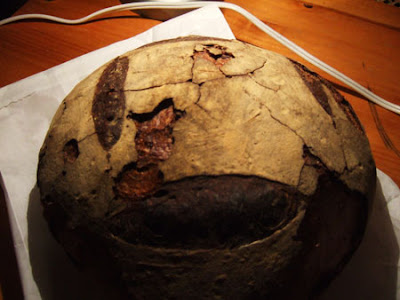I wanted to share with you two videos that I am particularly proud of. I did them both recently for The Feedbag.
Category Archives: video
The Premiere of Food Party!
Although not historical, I wanted to make everyone aware of the premiere of Food Party, created by my food friends and colleagues Thu Tran and Zachariah Durr. Food Party’s first season on IFC debuts Tuesday, June 9 11:15pm ET/PT.
From the official press release:
“Food Party is a fantastical, food-centric series created and hosted by Brooklyn fringe artist, Thu Tran, and a motley mix of unruly puppets who serve as her culinary crew. Maybe best described as a psychedelic melding of Pee Wee’s Playhouse and The Rachael Ray Show with a dash of J-Horror vibe, FOOD PARTY is shot on location in a technicolor handmade, cardboard kitchen. Each episode is a new gastronomical adventure as Thu interacts with a cavalcade of puppets, humans, baked goods, vegetables, and other critters, and embarks on journeys to bizarre, unexpected lands. “
Be sure to check it out! And in the meantime, cruise by the official website.
Bacardi: The Original Mojito Since 1862?
From The Intoxicologist is in:
“BACARDI®, the world’s number-one selling rum, today announced the launch of a new multi-media advertising and marketing campaign that emphasizes the brand’s 147-year history and rum making expertise. Featuring an all-new BACARDI Mojito television spot entiled “Eras,” the campaign seeks to convey the message that the best Mojitos are made with BACARDI, the innovative rum brand first used to make this legendary cocktail.”
Permit me to nerd out for a moment.
“Cuba is the birthplace of the mojito, although the exact origin of this classic cocktail is the subject of debate. One story traces the mojito to a similar 16th century drink, the “El Draque,” in honor of Sir Francis Drake. It was made initially with tafia/aguardiente, a primitive predecessor of rum, but as soon as Spanish rum became widely available to the British (ca. 1650) they changed it to rum. Mint, lime and sugar were also helpful in hiding the harsh taste of this spirit. While this drink was not called a mojito at this time, it was still the original combination of these ingredients..”
So while a combination of ingredients similar to the mojito existed, in the 19th c. it was being drunk by the Cuban working class. Definitely not Victorian tarts in spangly dresses.
I’ve also read that “The earliest “mojito” recipes…found are from 1931 and 1936 editions of a Sloppy Joe’s Bar Manual.” Sloppy Joe’s was a famous bar in Cuba, where Hemingway apparently popularized the drink.
Bacardi was founded in Cuba, and it was known for refining what was a previously unrefined drink. Rum was a dark pungent spirit; Bacardi classed it up by running it through a charcoal filter, creating a much lighter liqour appropriate for swanky bars.
And perhaps that’s what happened to the Mojito; it transformed from the rugged El Draque, to the gentile Mojito with the creation of Bacardi Rum.
Read up for yourself, and weigh in:
The History of the Cuban Mojito
Other Rum drinks from the 1860s:
P.S–Nothing personal against mojitos. They’re delicious.
Try This At Home: Make Yeast Appear–OUT OF THIN AIR!
Eggnog Goes Better With Booze
From Jeff via NPR: Many old cocktail recipes contain raw eggs, including this recipe for Egg Nogg. It’s a practice that died out probably around the time salmonella came into the picture. But never fear! NPR shows us that the alcoholic content of, in this case, Eggnog is enough to inhibit the growth of harmful bacteria.
Video: More Evidence That Eggnog Goes Better With Booze (NPR)
And for further old-timey cocktail reading (via Graham): Ladies United for the Preservation of Endangered Cocktails
“This site is dedicated to the Gin Fizz, the Widow’s Kiss, and the Singapore Sling – the drinks our mothers and grandmothers drank, the drinks we strive to save from extinction as a small measure of remembering those great women and their great cocktail parties.”
Flavoring as a Cause of Death

 (Illustration: Zachariah Durr; Photo: The Daily Telegraph)
(Illustration: Zachariah Durr; Photo: The Daily Telegraph)
An argument could be made that in current society we take certain steps to flavor our animals before we slaughter them. With beef, for instance, cattle are bred, genetically modified, and are fed different diets to produce an ideal flavor and fattiness to the meat. But only in historic cuisine, like with the Ortolan, have I found a reference to seasoning an animal before it’s slaughtered. I also came across this recipe for turkey in Statesman’s Dishes and How to Cook Them by Mrs. Stephen J. Field, 1890. She says:
“Three days before it’s slaughtered, it should have an English walnut forced down its throat three times a day, and a glass of sherry once a day. The meat will be deliciously tender, and have a fine nutty flavor.”
All of this boozing of poultry strikes one as a little obscene. I can only imagine that cuisine has moved away from ‘pre-seasoning’ because it could be perceived as an act of animal cruelty. But perhaps that shows a bit of our naivete, and how far removed we’ve become from our food in the last 100 years. In 1890, people were hanging out with their turkeys before Thanksgiving. I bet that careful care from life to death gave the turkey a spectacular flavor that is a world apart from our freezed meats; not to mention the sense of pride the owner would have, roasting the bird and placing it on the holiday table.
After all, it’s just food. Right?
And on that note, I encourage you to take the time to listen to this episode of This American Life. It’s a Thanksgiving show from a few years ago, and it deals with the sticky subject of where to draw the line “between friend and food.” It includes a segment on our friend, the Ortolan.

